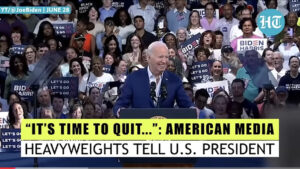
New York Times in its editorial dated June 28, 2024 pressed on President Joe Biden to exit the presidential race.
Elections in any part of the globe are landmark events, but a U.S. presidential election has exceedingly more economic and geo-political import. This translates into unflagging engagement and scrutiny from a rapt audience the world over. Elections are also a time when the role of the media becomes more pronounced and proactive. This is more so in regions where rightwing figureheads have steadily grown in power by stoking fear of people from racial and ethnic minority groups and attempting to consolidate people on religious, ethnic or racial lines.
The United States is not immune to divisive politics. The legacy of Donald Trump’s presidency draws from its ability to reimagine national identity on majoritarian lines, one in which the immigrant is the “dangerous other.” During the presidential debate on September 10, Trump said of Haitian immigrants: “In Springfield, they are eating the dogs. The people that came in, they are eating the cats.”
Other ingredients of it are an invasion of civil liberties, as is cataloged in Trump’s linear and increasingly trenchant discourse on women’s right to abortion, and multifarious machinations aimed at the creation of pliant institutions. The ascendance of several ideologically right-leaning judges appointed during the time Trump was in office gives potency to the latter accusation.
These political maneuvers represent a grave threat to a nation’s pluralist traditions and indeed its democracy. They also lead to a more fractious political field. In this environment, what role is the media obliged to play? Should it be an information-disseminating platform with opinions restricted to the editorial pages? Or should the media don a more vocal, ideological position, which means its identification as a political mobilizer will be inevitable? Will it reduce the appeal of political extremes? Or will it expand the fault-lines in society?
These questions were thrown into prominence after The New York Times helped mobilize public opinion against President Joe Biden’s decision to run for a consecutive term. “The greatest public service Mr. Biden can now perform is to announce that he will not continue to run for re-election,” NYT said in its editorial on June 28. The newspaper is allegedly said to have aided the Democratic Party’s insiders’ plot to replace Biden with a younger and more formidable candidate, leading to Vice President Kamala Harris’ ascension. But, if this is true, in playing a part in orchestrating the changeover, didn’t The Times flout journalistic principles? A cross section of the people have been contemplating that question intensely, with no consensus.
Those among the general readers who defend the Times’ perceived role in Biden’s exit from the 2024 race argue that at a time when democracy is at a dangerous inflection point, there must be an alliance among the liberal political parties, civil society groups and the media. In their assessment, the fight to safeguard democracy calls for collective planning and action. This constituency asserts that if the Times had failed to highlight Biden’s lackluster candidacy and call for a revamp, it wouldn’t be neutrality. According to them, it would be nothing short of dereliction of its moral obligation to safeguard America from the politics of exclusivism represented in Trump, just when such politics might reinvigorate if Trump were to return to power.
But in general a newspaper’s open affiliation for a political party also means that its readership gets restricted to one end of the political spectrum, limiting its capacity to generate public consensus on vexing questions. There is also the “commerce angle.” Is it really a moral arc that propels a publication toward a political party, or is it simply the calculation of which political posturing would sell more?
Importantly, how did we end up so fragmented? According to David Schultz, a distinguished professor at the Hamline University who has authored more than 40 books on various aspects of American politics, during the 1970s, though the Republican Party and the Democratic Party were ideologically diverse, “their vast majority converged to the center,” with “very little political gridlock.” “The centrists of the two parties were also close to each other,” he said. But as America transitioned from a manufacturing economy to a service-based economy with the loss of seven million manufacturing jobs, people’s lifestyles and political positions grew apart. The rural population leaned toward the Republicans and those living in the urban areas mostly identified with the Democrats.
This led to the creation of niche readerships with a strong political outlook. To create a neutral media, perhaps the first uphill task is to create a more neutral society by bridging the economic gap. As the watchdog of the government and its economic priorities, that job is for the media to kickstart.



